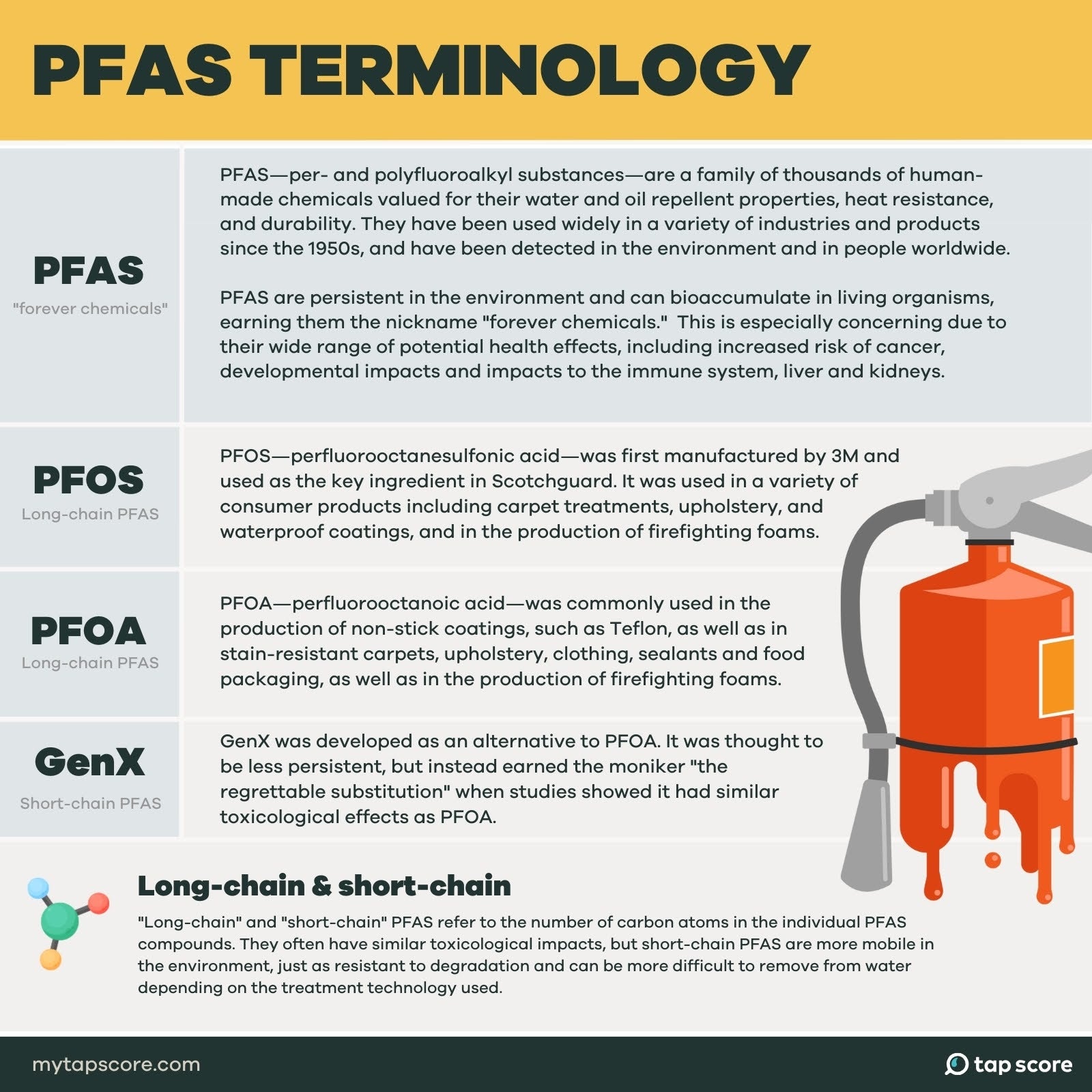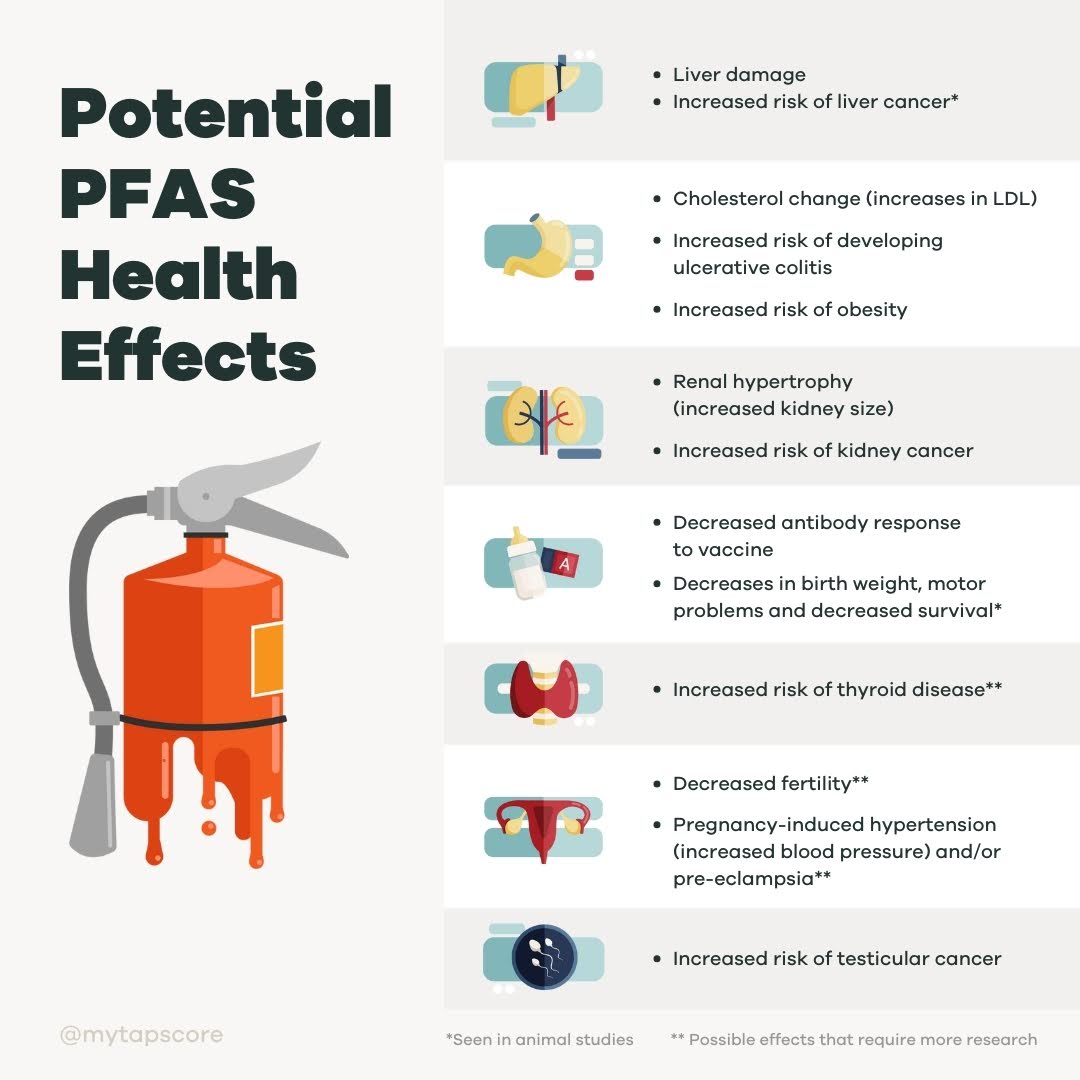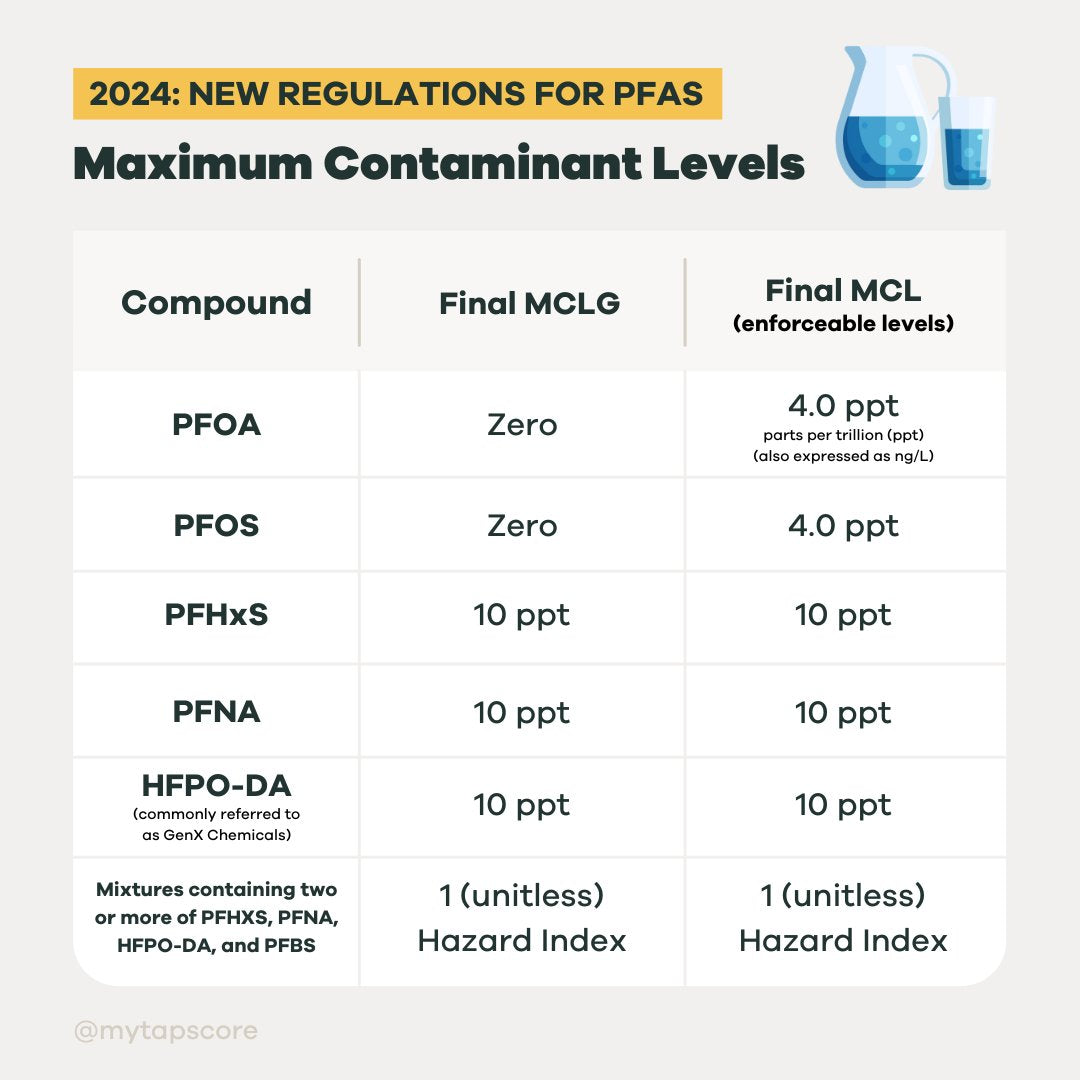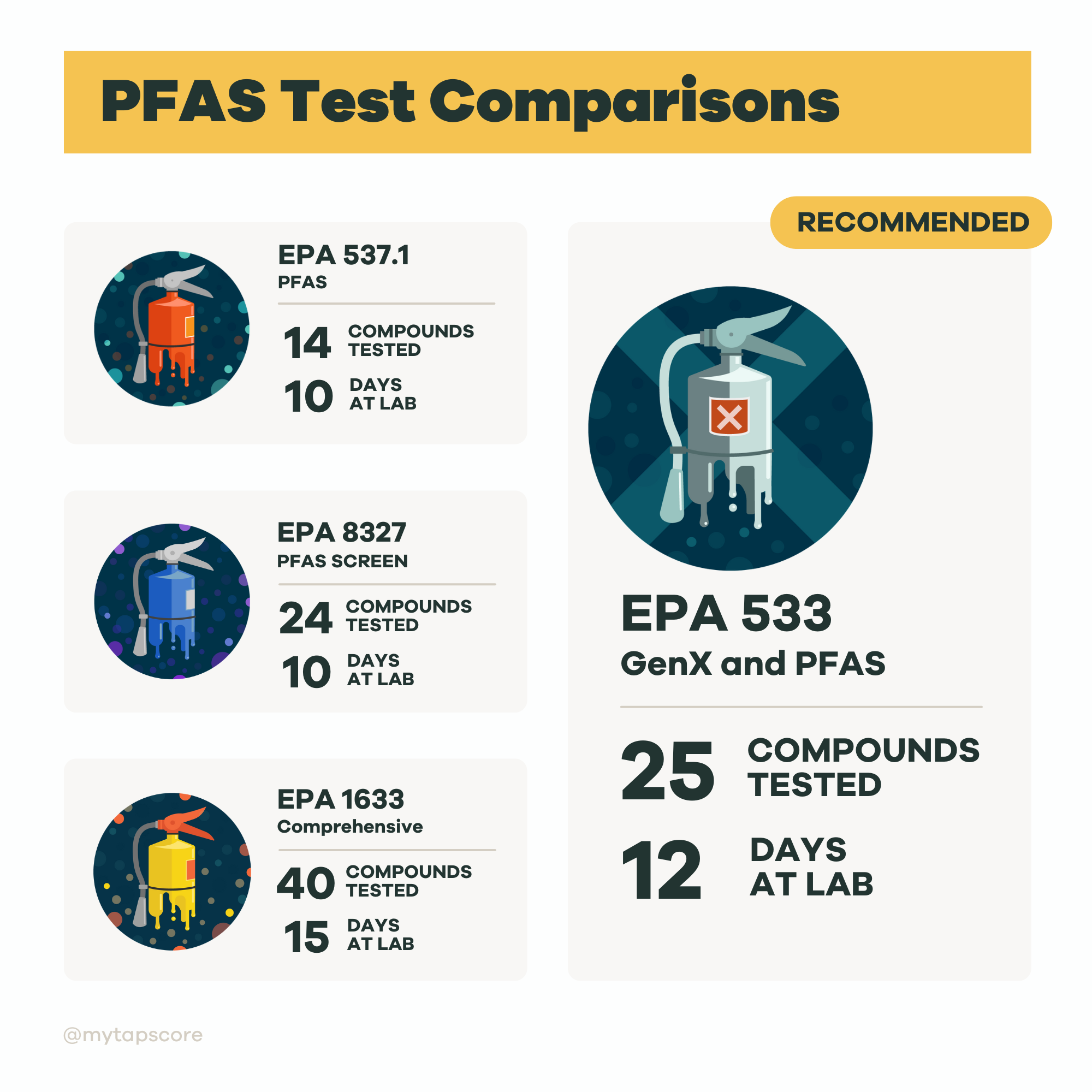
PFAS in Drinking Water: Everything You Need To Know
Our blog is written by real experts— not AI. Each guide is carefully reviewed and updated based on the latest research. Plus, with no affiliate links, you can count on unbiased insights you can trust.
Per- and polyfluoroalkyl substances — or PFAS — have swiftly become one of the leading public health crises of our time, turning up in drinking water supplies worldwide. Dubbed “forever chemicals” due to their near-indestructible nature, they have been in use in a wide variety of consumer goods and industrial applications for decades.
In this ultimate contaminant guide, we’ll explore PFAS — their history, pervasiveness, and health effects including “regrettable substitutions” like GenX — as well as how to test for PFAS at home in order to keep your drinking water safe for you and your family.
Table of Contents:
- What Are PFAS?
- Are PFAS Harmful to My Health?
- How Can I Be Exposed to PFAS?
- Are There Federal Regulations for PFAS in Drinking Water?
- Are PFAS in Public Water Systems?
- How Common Are PFAS in Well Water?
- How Do I Test My Water for PFAS?
-
How Do I Remove PFAS from My Drinking Water?
Key Takeaways:
PFAS is an evolving subject — from health impacts to testing methods to regulation and treatment. Thankfully, we know much more now than ever before.
-
6 PFAS Are Now Regulated
The EPA announced enforceable Maximum Contaminant Levels (MCLs) for 6 PFAS. - 4 PPT for PFOS and PFOA
- 10 PPT for PFNA, PFHxS, and HFPO-DA.
- PFNA, PFHxS, PFBS, HFPO-DA will also be regulated as a group using a hazard index.
-
Lab Testing Is the Only Way To Test for PFAS
Do-it-yourself test strips or at-home test kits cannot test for PFAS. Samples must be mailed to a laboratory for analysis. There are a number of certified lab testing kits available for PFAS.
-
Certain Treatment Technologies Remove PFAS from Drinking Water
If you learn you have concerning levels of PFAS in your water supply, you can opt for home treatment technologies such as: activated carbon, reverse osmosis, nanofiltration, or anion exchange
-
NSF/ANSI Have Updated Their Certification Standards to Include PFAS
NSF/ANSI standards 53 and 58 have been updated to include PFAS. Look for the certification seal on your device’s packaging and confirm PFAS are listed among the contaminants certified for removal.
What Are PFAS or “Forever Chemicals”?
PFAS—per- and polyfluoroalkyl substances—are a class of thousands of fluorinated organic compounds with a wide variety of uses for both consumers and industries. These chemicals rely on the carbon-fluorine bond, the strongest bond in chemistry, to create nearly indestructible fluoropolymer coatings and products.[1]
Resistant to heat, oil, and water, PFAS make for really good surfactants, or substances that reduce the surface tension of water. This increases capabilities for cleaning, foaming, and coating.
How Were PFAS Invented?
PFAS were first synthesized in the 1930s by a chemist at DuPont named Roy Plunkett. While searching for a new kind of refrigerant gas, Plunkett accidentally discovered a waxy, non-stick substance that wouldn’t dissolve in anything and could make other materials more durable and long-lasting. The substance was named “Teflon”™.
PFAS use exploded over the course of the 20th century, finding their way into everything from leather treatment, structural fabrics and corrosion prevention to cell phone parts, kitchenware, fast food packaging, stain-repellents, cosmetics and even dental floss. In the 1960s, the United States Navy developed a firefighting foam in conjunction with manufacturer 3M using two new PFAS compounds:
- PFOA (perfluorooctanoic acid)
- PFOS (perfluorooctane sulfonic acid).
PFOA and PFOS belong to a group of older, longer-chain PFAS often referred to as “C8s” (for their 8-carbon chain structure).
When Did PFAS Become a Problem?
Despite some red flags in the 1960s, PFAS started to trouble researchers in the 1990s, when they began detecting them in the environment worldwide. In the 2000s advancements in laboratory capabilities allowed for more accurate measurement of low concentrations of PFAS and their potential for adverse health effects.
The properties that make PFAS so miraculous are also what make them so problematic. In addition to their potential health effects, there are no known means of environmental degradation (i.e., not sunlight, not bacteria, etc.) and destroying them in a laboratory or with technology in the field is both expensive and difficult.
A massive class-action lawsuit was launched against DuPont in 2001. The case led to a series of epidemiological studies on the effects of PFAS and to the phasing out of certain PFAS (particularly PFOS and PFOA) for a suite of new substitute chemicals.
Are PFAS Microplastics?
No, PFAS — per- and polyfluoroalkyl substances — are not microplastics. However, both PFAS and microplastics are emerging human-made contaminants of environmental concern.
Microplastics are also a complex class of chemicals, but their chemical composition is distinct (rather than the thousands of distinct variations of PFAS). Plastics are technically polymers, and they have many applications due to their ability to be shaped when soft and then retain a shape when hardened.
What’s the Difference Between PFAS and PFCs?
Commonly mistaken for PFAS, PFCs — or perfluorochemicals, a large class of chemicals — are used in two different contexts. In one context, PFAS are part of PFCs, and in the other, they are not.
When “PFCs” refer to a subset of perfluorinated chemicals called perfluorocarbons, they are not PFAS. PFAS and PFCs are used in different industries and have different toxicity profiles. Notably, PFCs are not considered toxic in the way PFAS are, but they are problematic greenhouse gasses.[19]

What Are GenX Chemicals?
GenX (hexafluoropropylene oxide dimer acid or HFPO-DA) is a PFAS compound that was developed as a replacement for PFOA. It is a smaller molecule expected to be less persistent in humans and the environment. GenX was introduced in Teflon™ products in the early 2000s (along with about 150 other chemicals) by DuPont/Chemours around the time that PFOA was declared toxic to humans.
GenX is used primarily in non-stick coatings and water-repellent textiles. By 2017, however, studies began to associate GenX with toxicological effects similar to PFOA, earning GenX the moniker, the “regrettable substitution.”[9]
What Are the Health Effects of PFAS?
PFAS have been linked to a number of negative health impacts.[3] These potential impacts include:
- Liver damage
- Cholesterol changes
- Increased risk of obesity
- Increased risk of kidney cancer
- Decreased fertility
- Decreased birth weight
- Increased risk of thyroid disease
Despite public interest groups voicing concerns regarding the carcinogenicity of PFOS and PFOA, many years went by without action or regulation.[4]
PFAS behave quite uniquely. They partition not only into fat cells, but also into your blood, protein, and liver. This means more traditional risk assessment models aren’t completely accurate. Moreover, studies are ongoing, bringing new aspects to light almost everyday.

Do PFAS Affect Pregnant Women and Children?
In addition to the impacts above, studies show unborn children could be exposed to PFAS in utero.[5] Some studies have suggested PFAS is transferred through breastfeeding, but there isn’t enough conclusive evidence to support it.
Children have shown decreased response to vaccines in correlation with higher PFAS blood levels.[6] Peer-reviewed studies have also linked PFAS exposure to developmental effects or delays in children, including behavioral changes, bone variations, or accelerated puberty.
What Are the Health Effects of GenX?
GenX is a type of PFAS compound that has also been linked with negative health effects to the kidneys, blood and immune systems, and increased cancer risk in the liver, pancreas, and testicles.[7]
It’s worth noting that studies have tackled PFAS on a substance by substance basis, amounting to information on some 50 compounds out of the many thousands of PFAS in circulation (estimates range from 4,000 to 9,000 identified compounds).
We still have very little information to tell us what the compounding effects of multiple PFAS have on the body.
How Can I Be Exposed to PFAS?
You can be exposed to PFAS by:
- Inhalation of air pollutants
- Skin contact with products containing PFAS (although transdermal exposure is tricky and warrants further research)
- Ingestion of contaminated food and water
Common sources of PFAS contamination include:
- Eating fish, meat or fruits and vegetables that have been exposed to or grown in contaminated water or soil
- Eating food that has been in contact with PFAS-containing packaging or non-stick cookware
- Drinking contaminated water
Can I See, Smell or Taste PFAS?
No, PFAS are tasteless, scentless, and invisible to the naked eye. They are tiny chemical compounds that enter our bloodstream.
Do PFAS Affect Plumbing?
No, PFAS do not have any negative impacts on piping or pipe systems. Additionally, PFAS are not a part of PVC piping.
How Common Are PFAS in the United States?
Due to the robust production of PFAS, studies show that most people in the United States have been exposed to the chemicals. Because they are highly soluble in water, most drinking water sources that have been tested (which include lakes, rivers, tributaries, and groundwater) have revealed varying levels of PFAS.[3]
According to the Environmental Working Group (EWG)’s database, PFAS has been found in drinking water in at least 1,517 locations across 49 states. GenX has been detected around chemical plants all over the world. The exact extent of PFAS contamination is not known, however, as testing is limited and expensive.
Should I Be Concerned About PFAS in Drinking Water?
Depending on where you live, your PFAS-related drinking water concerns should not exceed that of other pressing water contaminants like lead, nitrates, and bacteria. The EPA estimates that 80% of the average person’s PFAS exposure comes from consumer products such as cookware, cosmetics, food wrappings, stain and water-resistant clothing, and carpet and furniture treatments, and only 20% from drinking water. These exposure estimates increase for those living near airports, military bases, and manufacturing facilities.
GenX and PFAS Water Test
Test your drinking water by EPA 533 with our most recommended PFAS test kit that analyzes for 25 compounds including GenX, PFOA, and PFOS.
Are There Federal Regulations for PFAS in Drinking Water?
Yes, there are. In April 2024, the EPA announced Maximum Contaminant Levels (MCLs), which are legally enforceable limits, for six PFAS compounds:
- 4 PPT (parts per trillion) each for PFOS and PFOA
- 10 PPT each for PFNA, PFHxS, and HFPO-DA (or GenX)
- Additionally, PFNA, PFHxS, PFBS, and HFPO-DA (or GenX) will be regulated together as a group using a hazard calculation index (1.0 unitless)
What Is a Hazard Calculation Index for PFAS?
Not a common approach to contamination regulation, a hazard calculation index follows several steps:
- The concentration of each individual PFAS within the group of four is measured and compared to a “health reference value.”
- The four hazard quotients are added up, resulting in a hazard index.
- If the hazard index is greater than 1.0, then the mixture is considered to be a potential risk and the water system would be in violation of the regulation.

What Do These Regulations Mean for Water Utilities?
Enforceable MCLs for PFAS will require public water utilities to:
- Monitor for these specific PFAS through 2027
- Keep the public informed about the levels of these PFAS in their water systems
- Reduce PFAS levels in drinking water if they exceed the MCL
- Implement solutions by 2029 (five years) before they will be considered in violation.[11]
The OEHHA Public Health Goals suggest that exposure to certain PFAS compounds can be harmful at levels as low as 1 PPT or less.[12]
Note: PFAS mitigation comes at a cost. Despite the federal government’s pledge to aid in combating PFAS (at $5 billion over five years), many public water utilities have already expressed concern over the significant expected costs of PFAS removal. Some of these costs are likely to land on consumers, resulting in rate hikes across the board.
Are PFAS in Public Water Systems?
PFAS have turned up in public water systems nationwide. According to a recent US Geological Survey study, at least 45% of the nation’s tap supplies tested positive for the presence of at least 32 types of PFAS.[17]
If your tap water comes from a public (municipal) water utility, everything from the EPA’s MCL requirements to the potential rate hikes applies to you. Public water systems are the ones performing frequent testing, assessing the levels of PFAS in their supplies, and determining how much work they’ll need to do to meet the proposed MCLs and protect public health.
PFAS monitoring results will begin to appear in Consumer Confidence Reports (CCR); they are mandatory where PFAS compounds are regulated. The Environmental Working Group (EWG) has put together an interactive PFAS water contamination map which relies on pooling information as it is released.[13] Tap Score’s City Water Project (CWP) is another resource that provides regional water quality data, city-by-city.
How Common Are PFAS in Well Water?
PFAS in private well water is relatively common, depending on where in the US you live. A USGS study from 2022 found PFAS in 60% of its 254 samples from across 16 states.[15] The regions with the most exposure to the chemicals were the Eastern Seaboard, Great Lakes, Great Plains, and Central and Southern California.
If you source your water from a private well, PFAS mitigation efforts are largely your responsibility. Private wells are not monitored by any organizational body. It’s very important to stay alert and aware of potentially hazardous activities and sites in your region (e.g. airports, military bases, factories, etc.) that could increase PFAS contamination. Remember to test your well water annually.
How Do I Test My Water for PFAS?
The only way to test your water for PFAS is to collect a sample and have it sent to a certified laboratory. While the highly specialized testing methods make PFAS testing somewhat more expensive than most tests, lab testing your water for PFAS, even just once, is a worthy investment.
Can I Test for PFAS at Home?
No, unfortunately testing for PFAS using at-home or DIY test strips is not possible. Test strips are not designed to test for PFAS. Test strips do not have the sensitivity or capability to detect "forever chemicals."
How Are PFAS Tested in a Laboratory?
PFAS testing uses an analytical chemistry technique called liquid chromatography with tandem mass spectrometry (LC-MS/MS). LC-MS/MS is highly sensitive and can be used to measure certain compounds (like PFAS) down to very low levels. PFAS testing demands a high level of analytical sensitivity to ensure accuracy.
The EPA’s team of scientists developed, validated, and published five methods for laboratories to test for PFAS in drinking water. Methods for non-potable water and air have been developed as well. [14]

Note: PFAS are evaluated at extremely low concentrations. The EPA’s initial health advisory for PFAS (70 PPT) was more than 100x lower than MCLs for more common water contaminants like arsenic and nitrate (10000 PPT and 1000000 PPT, respectively).
Which PFAS Test Is Right For Me?
The PFAS water test kit tests for 14 of the most common PFAS. It is helpful for anyone concerned about PFAS in their drinking water, and the most popular choice.
The PFAS and GenX kit tests for 25 PFAS according to EPA's Method 533. The recommended choice, it is helpful for those served by a water supply that is near industrial sites, airports, or military bases, or is otherwise known to be contaminated.
The EPA 1633 kit is the most comprehensive PFAS test available. It provides specialized analysis of 40 PFAS.
The EPA 8327 PFAS Screen kit tests for 24 PFAS. It is helpful for those looking for a quick glimpse at their PFAS situation because it is more affordable, but that's also because it is less sensitive than the options above.
Note: Because PFAS testing is highly specialized, collecting a test sample requires care and attention to detail. Pay extra attention when collecting your samples. Cross-contamination is extremely easy, impacting the reliability of test samples.
Read our guide to the Best Way to Test for PFAS in Drinking Water to learn more.
If you discover your water supply has increased levels of PFAS, there are household treatments you can try.
How Do I Remove PFAS from My Drinking Water?
Whether you’re on public water or a private well, there are a number of treatment technologies you can use to help remove PFAS from your drinking water, including:
- Activated carbon
- Reverse osmosis
- Nanofiltration
- Anion exchange
If you have PFAS in your tap water, the most appropriate technology depends on the specific compounds present in your water. PFAS are typically divided into two groups: long-chain and short-chain PFAS. Some treatment technologies work better against one group, some against the other.
What Is the Difference Between Long-chain and Short-chain PFAS?
Long-chain PFAS contain 6 or more carbon atoms and include PFOS and PFOA. Due to their added length, they have a tendency to bioaccumulate, or increase in concentration, in your body for longer amounts of time.
Short-chain PFAS contain 5 or fewer carbon atoms and include perfluoroalkyl sulfonic acids (PFSAs) like PFBS. While they are assumed to have less potential for bioaccumulation in your body, they are highly mobile in soil and water and spread very easily throughout the environment.
The “chain” refers to the number of carbon atoms that make up the carbon-fluorine backbone of these compounds. PFAS persistence relies upon this carbon-fluorine bond, which in turn directly impacts which treatment methods are more or less effective.
Does Activated Carbon Remove PFAS?
Yes, both granulated activated carbon filters (or GAC, filled with a porous, granular carbon material) and carbon block filters (composed of compressed, powdered activated carbon) can be effective in reducing the older, longer chain PFAS compounds (like PFOS and PFOA).
Activated carbon filters can be installed at either the point-of-entry (where the service pipe meets your home) and the point-of-use (either under the sink, directly at the faucet, or in a countertop pitcher). As water flows through an activated carbon filter, chemicals like PFAS stick to the carbon particles. Replacing your filter regularly is key to its effectiveness.
Absorption rates reduce notably with the shorter chain PFAS such as PFBA and PFBS.
Does Reverse Osmosis Remove PFAS?
Yes, reverse osmosis (RO) is considered to be extremely effective against a range of PFAS, including short-chain PFAS.[18] RO works by using high pressure to push water through a semipermeable membrane with very small pores; the pores allow water to pass through but keep many contaminants from doing so.
RO treatment systems often include an activated carbon stage. It’s worth noting that RO systems use more water than the other treatment methods listed.
Does Nanofiltration Remove PFAS?
Yes, nanofiltration (NF) is considered to be extremely effective against a range of PFAS, including short-chain PFAS. Similar to RO, NF uses pressure to push water through a membrane. Nanofiltration delivers coarser filtration, however, allowing water to retain minerals that RO would otherwise remove.
Does Ion Exchange Remove PFAS?
Yes, ion exchange, specifically anion exchange (as opposed to cation), is considered effective against certain PFAS compounds (specifically, short-chain compounds).
Ion exchange involves passing water through a resin composed of small, charged beads that act like magnets — they attract and hold on to compounds of the opposite charge, removing these compounds from the water.
Do Water Softeners Remove PFAS?
No, water softeners are not effective at removing PFAS from drinking water. Water softeners that use cation exchange technology to remove positively charged contaminants (like calcium and magnesium) will not remove negatively charged PFAS compounds.
Does Activated Alumina Remove PFAS?
No, activated alumina is not known to be effective against PFAS. Activated alumina relies on adsorption to remove contaminants like arsenic, fluoride, and selenium.
Does Boiling Water Remove PFAS?
No, boiling water does not remove PFAS.
Does Distillation Remove PFAS?
Yes, water distillation does remove PFAS. However, distillation also removes all the beneficial minerals in water and is very energy intensive. Drinking distilled water is not recommended as a part of a healthy diet.
Do Refrigerator Filters Work Against PFAS?
Refrigerator filters are not certified for PFAS removal. However, PFAS reduction depends on what filtration technology your fridge is equipped with. Common fridge filters that use activated carbon should be effective in removing long-chain PFAS.
Do I Need A Shower Filter for PFAS?
No, at the moment there isn't enough conclusive evidence to show that showering in PFAS water would raise your health risks, so buying a shower filter for PFAS alone isn't necessarily a worthwhile investment. More studies are ongoing.
Can Household Pitcher Filters (like Brita or PUR) Reduce PFAS?
Most common pitcher filters are not certified for PFAS removal. However, most pitcher filters (including Brita and PUR) use GAC filters and activated carbon has proven effective in removing long-chain PFAS.
The Brita Elite filter is certified for PFAS removal — specifically PFOS and PFOA — to NSF/ANSI Standard 53.
What Do Brita Pitchers Filter Out?
PUR Filters: Unbiased Overview of Contaminant Removal
Does Berkey Remove PFAS?
Berkey water filters are not certified for PFAS removal. While the exact materials of the Black Berkey Elements are unknown, it is most likely a form of carbon block filtration. Carbon block technology has proven effective in removing long-chain PFAS.
Berkey Water Filters: An In-Depth Analysis of Performance and Certification
Which NSF Standard Is the Right Certification for PFAS Reduction?
There are two relevant NSF/ANSI standards for PFAS reduction:
- NSF/ANSI 53: Drinking Water Treatment Units—Health Effects
- NSF/ANSI 58: Reverse Osmosis Drinking Water Treatment Systems
Within these two standards are three PFAS-related certifications a product can receive:
- PFOS Reduction
- PFOA Reduction
-
Total PFAS Reduction
-
- Includes perfluoroheptanoic (PFHpA), perfluorohexane sulfonic acid (PFHxS), perfluorononanoic acid (PFNA), perfluorooctanoic acid (PFOA) and perfluorooctane sulfonate (PFOS), perfluorobutanesulfonic acid (PFBS), perfluorodecanoic acid (PFDA)
-
This means a device can be certified to reduce PFOS or PFOA individually, or to reduce all seven different PFAS compounds (including PFOS and PFOA) under the moniker of “Total PFAS.” [20]
How Do I Know A Filter Is Certified For PFAS?
Both NSF/ANSI 53 and 58 can be obtained for the reduction of many different compounds. Gaining the certification for some compounds does not mean that it effectively reduces every possible compound covered by the certification
- Look for the NSF seal and a disclaimer on the product, packaging, or specifications.
- In addition to meeting the material and physical requirements of each standard, devices earn certifications based on the specific reduction claims they list: Make sure PFAS compounds are listed.
Quick Guide to Certified Water Filters for PFAS
 Each of the above systems vary in price, installation and operational upkeep. Precise effectiveness is dependent on the particular PFAS in your water. As of yet there is no one-size-fits-all solution. We recommend you test your water before investing in treatment solutions.
Each of the above systems vary in price, installation and operational upkeep. Precise effectiveness is dependent on the particular PFAS in your water. As of yet there is no one-size-fits-all solution. We recommend you test your water before investing in treatment solutions.
Read More
▾What Is the Best Way to Test for PFAS in Drinking Water
Certified Water Filters for PFAS
The Ultimate Guide To The Best Water Filters For Your Home 2024
What Do Brita Pitchers Filter Out?
Unbiased Overview of PUR Filters
Berkey Water Filters: An In-Depth Analysis of Performance and Certification
Sources and References
▾- Novel catalyst cleaves carbon–fluorine bonds to break down 'forever chemicals' | Phys.org
- Chemistry, Terminology, and Acronyms – PFAS — Per- and Polyfluoroalkyl Substances
- Our Current Understanding of the Human Health and Environmental Risks of PFAS | US EPA
- For decades, polluters knew PFAS chemicals were dangerous but hid risks from public | EWG
- Perfluoroalkyl substances (PFAS) and their effects on the placenta, pregnancy and child development
- Our Current Understanding of the Human Health and Environmental Risks of PFAS | US EPA
- NCDHHS: DPH: Epidemiology: OEE: GenX and other PFAS in the Cape Fear River Basin
- Per- and Polyfluoroalkyl Substance (PFAS) | AWWA
- FDA Studies: ‘Short-chain’ PFAS Chemicals More Toxic Than Previously Thought | EWG
- GAO | Persistent Chemicals: EPA Should Use New Data to Analyze the Demographics of Communities with PFAS in Their Drinking Water
- Per- and Polyfluoroalkyl Substances (PFAS) | US EPA
- Public Health Goals for PFOA and PFOS in Drinking Water- First Public Review Draft
- Interactive Map: PFAS Contamination Crisis: New Data Show 2,858 Sites in 50 States
- PFAS Analytical Methods Development and Sampling Research | US EPA
- USGS detects ‘forever chemicals’ in 16 states’ water wells | EWG
- For Residents - Private Residential Well PFAS Sampling Guidance
- Tap water study detects PFAS ‘forever chemicals’ across the US | USGS
- EPA | Technologies for Reducing PFAS in Drinking Water
- What are PFCs and How Do They Relate to Per- and Polyfluoroalkyl Substances (PFASs)?
- Testing Activated Carbon Systems for Total PFAS Reduction - WCP Online









